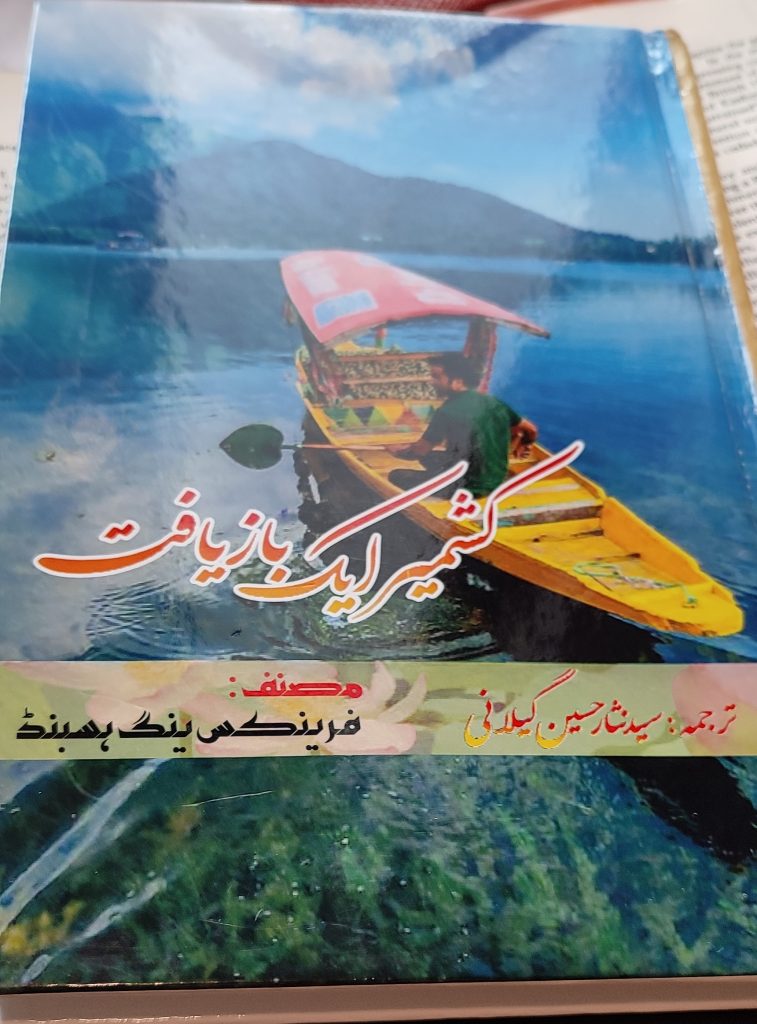Peace Watch » Editor's Take, Kashmir-Talk » NISAR GILANI’S TRANSALATION OF Younghusband
NISAR GILANI’S TRANSALATION OF Younghusband

Nisar Gilani’s Translation of
Kashmir, As I saw It.
By
Z.G. Muhammad
Irish poet Thomas Moore introduced our beautiful land to the Western World in the second decade of the nineteenth century with these opening verses of his magnum opus Lalla Rookh :
“Who has not heard of the Vale of Cashmere,
With its roses the brightest that earth ever gave”,
Most writers believe it was a great introduction that attracted European travelers, tourists, and adventures towards this Elysian land in the mighty Himalaya’s bosom. The great thing about some of these travelers is that they toured in the vales and dales of our land with their ears and eyes open. And on their way back, while narrating tales of their adventures, they did not forget to mention the agony, pain, and oppression of this land’s beautiful people. With their bags full of our stories of sufferings, the European travelers were the first ambassadors of Kashmir to the west.
William Moorecraft told the world around that ‘the Kashmiris were looked upon a little better than cattle’. The cost of killing a native Muslim was just Rs two. Knight, in his travelogue, ‘Where Three Empires Meet,’ tells the horrific tales of humans incarcerated in the dungeons in the fort on top of the iconic hillock of Srinagar for killing an animal by accidents. . Walter Lawrence tell the world about the despotic and discriminatory tax system to which the natives were subjected in the nineteenth century. Some of the travelogues and works by European adventures shook the conscience of some conscientious Europeans. Even the Christen missionaries who visited this beautiful land were deeply moved at this beautiful race’s pitiable conditions born out of twelve great tribes making to this from as far lands as Greece and Persia.
Kashmiris, a tiny nation behind the high ramparts of the mountains with thousands of years of recorded history, feel indebted to these Western travelers for having documented this land’s stories. The biggest irony has been that lots of Kashmiris have not read their stories as told by Europeans to the world because no serious effort has been made to translate these work into the State languages. Besides having been the state language for about one hundred and seventy years, Urdu has been de facto lingua franca that is read and spoken across the state. For the past some years across the dividing line, writers have shown interest in translating European travellers and writers into Urdu and Kashmiri languages, thus widening these works’ reach to a more significant chunk of the population of Kashmir and Urdu knowing readers. The latest translation of a European writer that has hit the stands is ‘Kashmir As It Was’ by Francis Younghusband.
Syed Nisar Gilani, a former revenue officer and famed television host, has translated this work published in the first decade of the twentieth century and titled it Kashmir Ek Bayazaft. The National Council for Promotion of Urdu, New Delhi, has been published, and it has been priced at Rs. 230. Gilani has dedicated the hardbound book to his mother and father.
I might have written it earlier. Let me write it at the cost of repetition, ‘the entrancing beauty of our land has waxed even the most prosaic lyrical’, so one is surprised when European travellers lavish it with all praise. Younghusband starts his book with a quote from Bernier, the first European to enter Kashmir. In 1665, that was almost four hundred years back, he had written, “In truth, the kingdom (Kashmir) surpasses in beauty all that my warmest imagination had anticipated.” Bernier has not been the only traveller who was spellbound; Kashmir has inspired Sanskrit, Persian, and Urdu poets’ scores. Comparing Kashmir with Switzerland, Younghusband frankly acknowledges, it excels this European beauty. ‘There is not the same wide sweep of Snowclad Mountains.’
For tens of millions of Urdu knowing readers in the sub-subcontinent and across the globe, Nisar Gilani has painstakingly spent two years translating this classic work on Kashmir. Besides providing an insight into the natural splendour of the Valley and administrative set up as existed in the early nineteenth century, it identifies the resources that, even if harnessed today, revolutionize the state’s economy. Lucidly, translated work in the chapter titled The Electric Scheme provides many a moot point for changing energy scenario of Kashmir. One of the moot points that instantly stuck my mind is the scheme drafted by Mr Fields and Maj Lobiniere for Jhelum’s dredging for preventing the recurrence of floods in Kashmir.
The books by Europeans like Younghusband translated in Urdu and other languages while enabling us to know about the environmental scenario as existed in19th and early 20th century also serves as a lodestar in drafting plans. I am amazed why such books should not be included in educational curricula.
Filed under: Editor's Take, Kashmir-Talk · Tags: Nisar Gilani, PUNCHLINE GreaterKashmir Z.G. Muhammad, Younghusband, Z. G. muhammad








